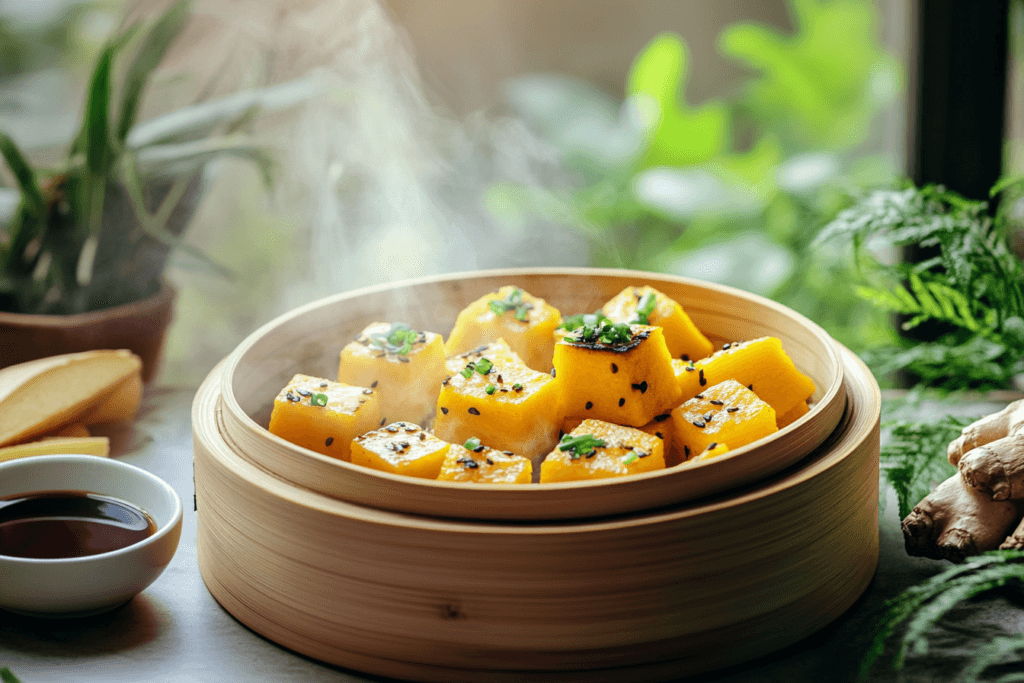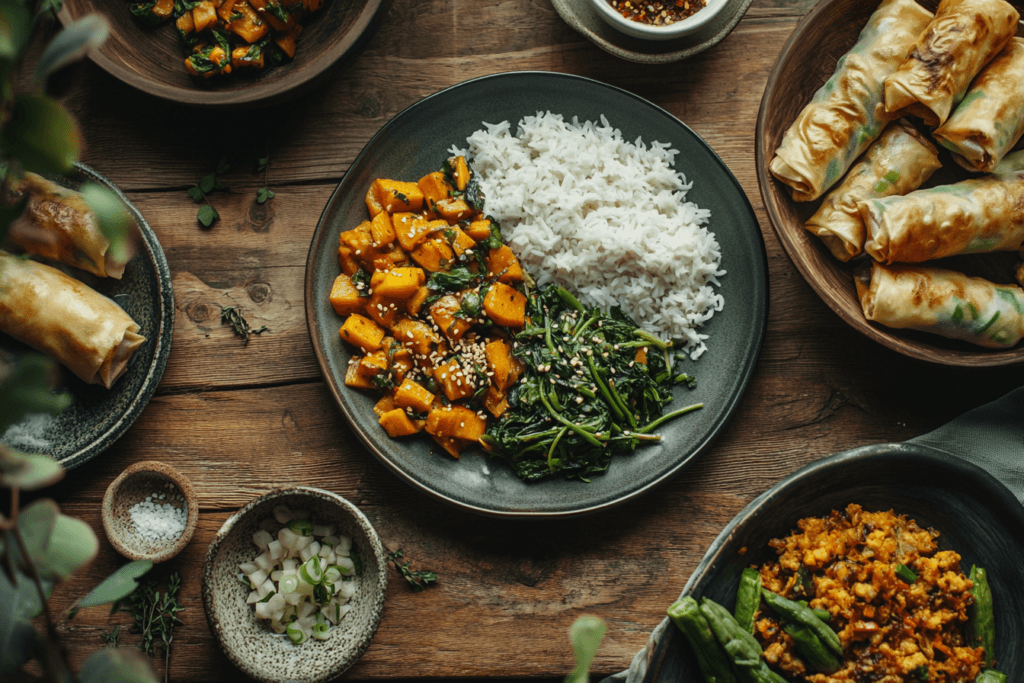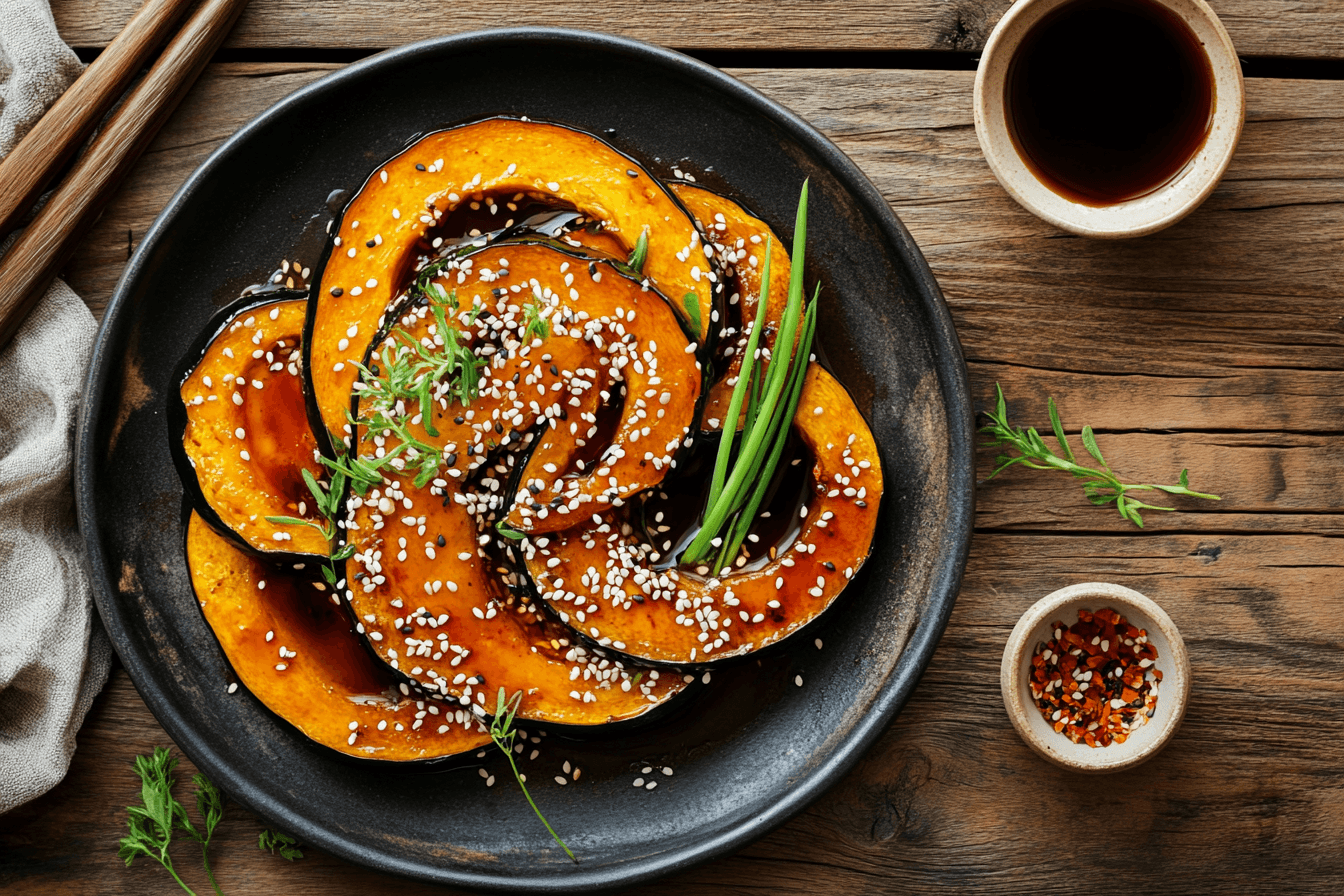Introduction
Kabocha squash, also known as Japanese pumpkin, is a gem in Chinese cuisine and beyond. Its naturally sweet, nutty flavor and velvety texture make it an incredibly versatile ingredient that shines in both savory and sweet dishes. Whether roasted, steamed, braised, or blended, Chinese squash recipes kabocha vegan bring a comforting balance of flavor and nutrition to every season. By combining traditional Chinese flavors with plant-based ingredients, you can create nourishing dishes that are as easy to prepare as they are satisfying to eat.
The goal of this article is to inspire you to embrace kabocha squash in your cooking repertoire, with detailed tips, techniques, and recipes that ensure your dishes turn out perfectly every time. Whether you’re a home cook looking for quick weeknight meals or a food enthusiast experimenting with new flavors, these recipes will bring the warmth and comfort of kabocha squash to your table. Let’s dive in!
Understanding Kabocha Squash in Vegan Chinese Recipes
Kabocha squash is often referred to as the Japanese pumpkin due to its round shape and vibrant orange flesh. However, it has a unique identity of its own that sets it apart from other types of squash. Known for its rich, sweet flavor with hints of chestnut, kabocha is a favorite ingredient in Chinese cuisine because it pairs effortlessly with soy sauce, sesame oil, and warming spices like ginger and five-spice powder.
In Chinese cooking, kabocha squash holds cultural significance as it symbolizes abundance and prosperity. Its bright color brings visual appeal to dishes, making it a common ingredient in celebratory meals. Additionally, its adaptability to various cooking methods means it can take center stage in soups, stir-fries, braises, and even desserts. Unlike other types of squash, the edible skin of kabocha adds texture and flavor when cooked, saving time on peeling and reducing waste.
Kabocha’s versatility doesn’t stop at its taste and texture; it’s also a nutritional powerhouse, making it an ideal choice for health-conscious individuals.

Nutritional Benefits of Kabocha Squash for Vegan-Friendly Dishes
One of the reasons kabocha squash has become a favorite in plant-based cooking is its exceptional nutritional profile. This humble yet versatile squash is a powerhouse of essential vitamins, minerals, and antioxidants that significantly contribute to overall health and well-being.
Kabocha is particularly rich in vitamin A, which supports healthy vision and boosts the immune system—especially valuable during flu season. Its vitamin C content helps combat oxidative stress, promotes radiant skin, and aids in faster wound healing. Additionally, it provides a good dose of vitamin E, an important antioxidant that protects cells from damage and supports heart health.
Another key benefit of kabocha squash is its high dietary fiber content. Fiber aids in digestion, promotes a feeling of fullness, and helps maintain stable blood sugar levels. With a low glycemic index, kabocha is an excellent choice for individuals managing diabetes or anyone looking for sustained energy without blood sugar spikes. Unlike other starchy vegetables, it delivers a nutrient-dense energy source without the heavy carb crash.
Compared to other varieties like butternut or acorn squash, kabocha stands out with its naturally sweet and creamy texture, requiring minimal seasoning to shine. Its lower calorie count makes it ideal for those aiming to maintain or lose weight while still enjoying satisfying, flavorful meals. Whether you’re seeking nourishment or indulgence, kabocha squash effortlessly provides both.
How to Select and Store Kabocha for Asian-Inspired Squash Dishes
To truly elevate your recipes, selecting the right kabocha squash is crucial. The quality of the squash can transform a dish from ordinary to unforgettable.
When choosing kabocha squash, prioritize one that feels heavy for its size, as this indicates dense, moist flesh. Inspect the skin for smoothness, firmness, and the absence of cracks or blemishes. Additionally, a dry, intact stem is a sign of freshness. Look for a dull, matte finish on the skin, which signals ripeness, while a shiny surface often suggests the squash was picked prematurely.
Once you’ve picked the perfect squash, proper storage is key to preserving its flavor and texture. A whole kabocha squash can be stored in a cool, dry place for up to a month. If you’ve cut into the squash, wrap the remaining portion tightly in plastic wrap or place it in an airtight container before refrigerating it for up to five days. For long-term storage, cooked kabocha can be frozen as purees or cubed pieces, making it a convenient option for soups, stews, and other recipes.
Although kabocha squash is available year-round, it reaches its peak sweetness and flavor during fall and winter. By following these selection and storage tips, you can ensure your squash is always fresh and ready to enhance your culinary creations.
Essential Ingredients for Chinese Squash Recipes Kabocha Vegan
Chinese-inspired kabocha squash recipes thrive on a harmonious balance of bold seasonings, fragrant herbs, and carefully chosen complementary ingredients. These elements work together to enhance the squash’s natural sweetness and nutty flavor, creating dishes that are both flavorful and satisfying. Here’s a breakdown of the must-have ingredients for these dishes:
| Category | Ingredients |
|---|---|
| Key Seasonings | Soy sauce, tamari (gluten-free option), sesame oil, miso paste, rice vinegar. |
| Aromatics | Garlic, ginger, scallions. |
| Sweeteners | Maple syrup, agave nectar. |
| Spices | Chinese five-spice powder, star anise, Sichuan peppercorn. |
| Fresh Ingredients | Bok choy, shiitake mushrooms, tofu, napa cabbage, fresh herbs like cilantro. |
These ingredients not only enhance the rich, nutty flavor of kabocha squash but also seamlessly capture the iconic and bold flavors that define Chinese cuisine. Furthermore, they work together to create a harmonious balance, ultimately elevating every dish to a new level of taste and authenticity. As a result, your meals will not only be flavorful but also reflective of traditional culinary excellence.
Top Cooking Techniques for Plant-Based Squash Meals
Mastering the right cooking techniques can truly take your dishes to the next level, ensuring that every bite not only delivers the perfect balance of texture, flavor, and presentation but also leaves a lasting impression. Moreover, with just a few simple methods, you can effortlessly transform kabocha squash into a wide variety of delicious and visually appealing meals. As a result, these dishes are sure to impress your family and guests alike, making your cooking both enjoyable and rewarding.
Roasting
Roasting brings out the natural sweetness of kabocha squash, transforming it into a dish with caramelized edges that are irresistibly delicious. To prepare, slice the squash into wedges, toss them with sesame oil, and season with a sprinkle of five-spice powder for an added depth of flavor. Roast the wedges in a preheated oven at 400°F for about 30 minutes, flipping halfway through to ensure even cooking. This simple method creates a versatile dish that works beautifully as a side or as a flavorful topping for salads and grain bowls.
Steaming
Steaming is an excellent way to preserve the nutrients in kabocha squash while achieving a tender, silky texture. This method is perfect for blending the squash into creamy soups or serving it as a simple, wholesome side dish. To steam, start by cutting the squash into cubes and placing them in a steamer basket over a pot of boiling water. Cover and let the squash cook for 15-20 minutes, or until it’s fork-tender. The result is a nutrient-packed ingredient ready to elevate any meal.
Braising
Braising is a fantastic method for infusing kabocha squash with bold, rich flavors as it gently simmers in a flavorful sauce. To begin, combine soy sauce, ginger, garlic, and vegetable broth in a pan, creating a savory base. Add cubed kabocha squash to the mixture and let it cook slowly over low heat until it becomes tender and absorbs the sauce’s delicious essence. This braised kabocha pairs beautifully with steamed rice or noodles, making it a comforting and satisfying dish for any meal.
Stir-Frying
For quick and flavorful results, try stir-frying kabocha squash with aromatic ingredients and fresh vegetables. Begin by sautéing garlic and ginger in a bit of sesame oil until fragrant. Next, add thinly sliced kabocha squash and fresh bok choy, letting them cook until tender yet crisp. Finally, finish the dish with a splash of tamari for umami flavor and a sprinkle of sesame seeds for a nutty crunch, creating a vibrant and delicious meal in minutes.
Soup-Making
Chinese squash recipes kabocha vegan are ideal for crafting creamy and comforting soups that require no dairy at all. For instance, you can blend steamed kabocha squash with vegetable broth, miso paste, and a drizzle of chili oil to create a nourishing bowl that is both flavorful and warming to the soul—perfect for cozy evenings or chilly days.
Chinese Squash Recipes Kabocha Vegan to Try
Now that you’re familiar with the essentials, it’s the perfect time to put your knowledge into practice with these delightful recipes. Each one not only highlights the incredible versatility of kabocha squash but also demonstrates how it can easily transform into flavorful, comforting, and highly nutritious dishes. Furthermore, these recipes are designed to impress, whether you’re cooking for yourself, your family, or guests. So, without further ado, let’s get cooking and bring these delicious ideas to life!
Vegan Kabocha Stir-Fry: An Easy Plant-Based Cooking Idea
This vibrant, quick-cooking dish is perfect for busy weeknights.
Ingredients:
- Kabocha squash (steamed and cubed)
- Bok choy
- Garlic, minced
- Tamari
- Sesame seeds
Instructions:
- Heat sesame oil in a pan and sauté garlic until fragrant.
- Add bok choy and stir-fry until wilted.
- Toss in steamed kabocha cubes and drizzle with tamari.
- Garnish with sesame seeds before serving.
Braised Kabocha with Black Beans for Nutritional Squash Recipes
This umami-rich dish is hearty and satisfying.
Ingredients:
- Kabocha squash, cubed
- Fermented black beans
- Soy sauce
- Ginger, sliced
- Vegetable broth
Instructions:
- Sauté ginger in sesame oil, then add black beans and soy sauce.
- Stir in cubed kabocha and pour in vegetable broth.
- Simmer until the squash is tender and the sauce is thickened.
Miso-Glazed Roasted Kabocha Squash for Vegan Winter Meals
This sweet-savory dish is a crowd-pleaser.
Ingredients:
- Kabocha squash, sliced into wedges
- Miso paste
- Maple syrup
- Rice vinegar
Instructions:
- Mix miso paste, maple syrup, and rice vinegar into a glaze.
- Brush onto squash wedges and roast at 375°F for 25 minutes.
Kabocha Squash Congee: A Comforting Vegan Chinese Dish
A warming, comforting meal perfect for colder months.
Ingredients:
- Kabocha squash, cubed
- Rice
- Water
- Ginger, sliced
- Scallions, chopped
Instructions:
- Cook rice with water and squash until creamy.
- Add ginger and scallions for flavor.
Asian-Inspired Kabocha Hot Pot: A Hearty Squash Dinner Idea
A shareable dish for family meals.
Ingredients:
- Kabocha squash, cubed
- Tofu
- Napa cabbage
- Shiitake mushrooms
- Soy sauce
Instructions:
- Simmer broth with soy sauce and ginger.
- Add kabocha, tofu, and vegetables, cooking until tender.
Fusion Ideas for Asian-Inspired Squash Dishes
For a modern twist, try incorporating kabocha squash into fusion dishes:
- Kabocha squash tacos with spicy chili glaze.
- Spiralized kabocha noodles with peanut sauce.
- Kabocha coconut curry soup infused with Thai flavors.

Cooking Tips for Perfect Chinese Kabocha Squash Recipes
To get the most out of your cooking experience:
- Microwave kabocha for a few minutes to soften the skin for easier slicing.
- Avoid overcooking, as it can turn mushy.
- Use a sharp knife to cut through the dense flesh effortlessly.
Serving Suggestions for Vegan-Friendly Squash Meals
Pair these recipes with steamed jasmine rice, fluffy quinoa, or savory noodles to create a perfectly balanced and satisfying meal. Additionally, you can elevate both the flavor and presentation by garnishing with freshly chopped scallions, toasted sesame seeds, or a drizzle of aromatic chili oil. Moreover, to make the meal even more indulgent, consider adding complementary sides such as sautéed greens, crispy spring rolls, or a refreshing cucumber salad. Together, these thoughtful combinations will not only round out your menu beautifully but also leave a lasting impression on your family and guests.
Health Benefits of Plant-Based Winter Squash Ideas
Incorporating kabocha squash into a vegan diet not only offers numerous health benefits but also adds versatility to your meals. For example, its richness in antioxidants, vitamins, and fiber makes it ideal for promoting digestion, boosting immunity, and supporting overall health. Furthermore, the natural sweetness and creamy texture of kabocha squash ensure that your dishes are both nutritious and delicious, making it a must-have ingredient in any plant-based kitchen.
FAQs on Chinese Squash Recipes Kabocha Vegan
Are kabocha and butternut squash the same?
No, kabocha and butternut squash are not the same. Kabocha squash, often referred to as Japanese pumpkin, has a sweeter, nuttier flavor and a denser, creamier texture compared to butternut squash. Additionally, kabocha has a green skin and vibrant orange flesh, while butternut squash has beige skin and a more mild, slightly nutty flavor.
Do you peel kabocha squash before cooking?
You don’t necessarily need to peel kabocha squash before cooking. Its skin becomes tender and edible when roasted, steamed, or braised, adding both flavor and texture to dishes. However, if you prefer, you can peel it for smoother textures in purees or soups.
What is kabocha squash in Chinese?
In Chinese, kabocha squash is commonly referred to as 南瓜 (nán guā), which translates to “pumpkin” or “squash.” Its use in Chinese cooking varies but often includes soups, stir-fries, and braised dishes.
Do you eat the skin of kabocha squash?
Yes, the skin of kabocha squash is edible. When cooked, the skin softens and blends well with the flesh, adding a slightly chewy texture and additional nutrients to your dish. It’s particularly popular to leave the skin on in roasted or steamed recipes.
Conclusion
Chinese squash recipes kabocha vegan is not only a versatile ingredient but also one that effortlessly brings comfort, nutrition, and vibrant flavor to your dinner table. Furthermore, whether you’re exploring traditional Chinese recipes or venturing into the exciting world of modern fusion dishes, the possibilities are truly endless. In addition, these recipes are designed to be both approachable and inspiring, making it easier than ever to experiment in your kitchen. So, if you’re ready to elevate your cooking and embrace plant-based cuisine, these ideas will undoubtedly motivate you to create delicious meals with confidence and ease.Explore more about the versatility of root vegetables like Murasaki sweet potatoes or try healthy dessert ideas like guilt-free sweet potato brownies. For soup enthusiasts, don’t miss this Instant Pot vegetable soup recipe!

